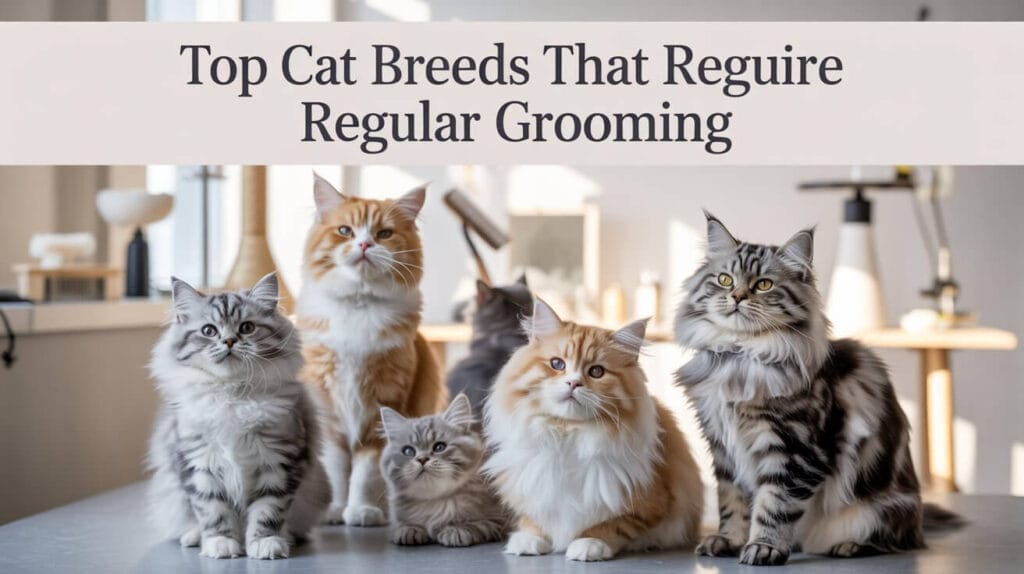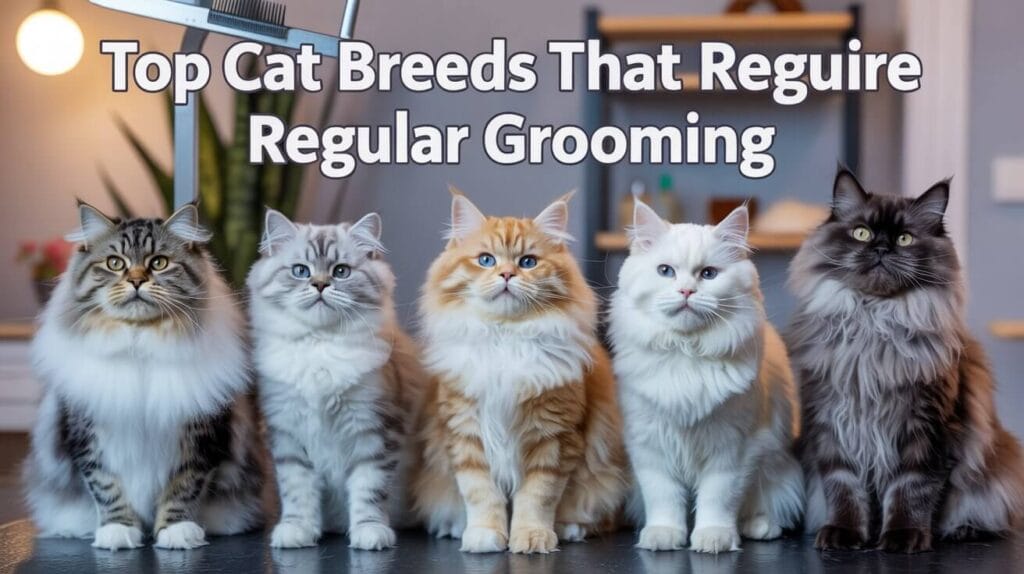Cats are famously clean creatures, often seen grooming themselves for hours. However, not all cats are created equal when it comes to coat maintenance. Certain cat breeds require more intensive grooming routines due to their long hair, dense undercoats, or susceptibility to matting and skin issues. For pet lovers and caretakers, understanding which breeds need more frequent grooming is essential to ensuring their feline companions remain healthy and happy.
In this comprehensive guide, we explore the top cat breeds that demand regular grooming. We’ll discuss their grooming needs, potential health issues, and tips for maintaining their coats between professional grooming sessions.
Why Regular Grooming Is Crucial for Some Cats
Grooming isn’t just about keeping a cat looking pretty; it’s a vital part of their overall health and hygiene. Long-haired and high-maintenance breeds are more prone to matting, skin irritation, and hairballs. Regular brushing, detangling, and sanitary maintenance help to:
- Minimize shedding and dander
- Prevent hairballs
- Detect early signs of health issues
- Keep the coat clean and tangle-free
- Improve blood circulation through brushing
- Avoid painful matting that can lead to skin infections

Let’s dive into the top breeds that require extra grooming attention.
1. Persian Cats
Persians are among the most iconic long-haired cats. With their luxurious double coats and flat faces, they require daily grooming.
Grooming Needs:
- Daily brushing to prevent matting
- Routine cleaning of tear stains around the eyes
- Regular sanitary trims
Risks of Neglect:
- Matted fur can lead to skin irritation
- Tear staining can become infected
- Shedding increases without consistent brushing
2. Himalayan Cats
Closely related to Persians, Himalayans also have thick, flowing coats that need diligent care.
Grooming Needs:
- Daily detangling
- Bathing every few weeks
- Eye discharge cleanup
Grooming Benefits:
- Keeps their long fur soft and manageable
- Prevents buildup of allergens
- Helps detect lumps, ticks, or fleas early
3. Maine Coon Cats
Maine Coons have a dense, water-repellent coat and a ruff around their neck, making grooming essential.
Grooming Needs:
- Brushing 2–3 times per week
- Occasional trimming of belly and tail hair
Why It Matters:
- Reduces shedding and tangles
- Prevents debris from getting trapped
- Maintains the natural oils of their skin and coat
4. Ragdoll Cats
With their silky, semi-long hair, Ragdolls are prone to tangles if not brushed regularly.
Grooming Needs:
- Brushing every other day
- Cleaning around the eyes and ears
Importance:
- Minimizes hairball formation
- Keeps their plush coat fluffy and clean
5. Birman Cats
Birmans have a fine, soft coat that doesn’t mat easily but still requires frequent brushing.
Grooming Needs:
- Brushing 2–3 times a week
- Nail trimming and ear cleaning
Grooming Tips:
- Use a soft-bristle brush to maintain the coat’s natural sheen
- Focus on high-shedding areas like the chest and underarms
6. Norwegian Forest Cats
Built for cold climates, these cats have a dense undercoat and water-resistant outer layer.
Grooming Needs:
- Weekly brushing, more often during shedding season
- Occasional baths
Health Consideration:
- Mats and knots can hide skin infections or parasites
7. Turkish Angora
The Turkish Angora’s single-layer coat is silky but still benefits from consistent grooming.
Grooming Needs:
- Brushing 2–3 times weekly
- Regular tail checks to avoid tangling
Why Grooming Helps:
- Maintains elegance and smooth coat texture
- Reduces allergens in the home
8. Balinese Cats
Often called “long-haired Siamese,” Balinese cats have a soft, flowing coat that’s less prone to matting.
Grooming Needs:
- Brushing once or twice a week
- Cleaning the ears and trimming nails
Additional Benefits:
- Strengthens the bond between pet and owner
- Reduces loose hair around the house
9. Somali Cats
Somalis have a fine, medium-length coat that’s dense and ticked.
Grooming Needs:
- Weekly brushing
- Regular inspection for parasites
Best Practices:
- Use a wide-tooth comb for detangling
- Introduce grooming early to reduce stress
10. Selkirk Rex
With curly, wool-like coats, Selkirk Rex cats are unique and require special attention.
Grooming Needs:
- Gentle brushing a few times a week
- Avoid over-brushing to preserve curls
Risks of Inadequate Care:
- Matting in curly areas like the belly and behind the ears
- Skin irritation under dense patches
General Grooming Tips for High-Maintenance Breeds
No matter the breed, all cats benefit from a grooming routine. Here are a few universal tips:
- Start early: Introduce grooming during kittenhood
- Use proper tools: Invest in brushes designed for your cat’s coat type
- Check for signs: Look for redness, swelling, or lumps during grooming
- Schedule routine trims: Especially for long-haired cats
- Keep it positive: Use treats and praise to make grooming enjoyable
Professional Grooming vs. At-Home Care
While at-home grooming is vital, professional grooming services offer additional benefits, especially for high-maintenance breeds:
Pros of Professional Grooming:
- Access to specialized tools
- Knowledge of breed-specific needs
- Sanitary and de-shedding treatments
When to Seek a Groomer:
- Severe matting
- Seasonal shedding
- Behavioral issues during home grooming
Our Pet Grooming Services in Different Areas:
- Mobile Cat Grooming Orlando
- Mobile Dog Grooming Orlando
- Mobile Pet Grooming Apopka FL
- Mobile Pet Grooming in Kissimmee FL
- Mobile Pet Grooming Winter Park FL
- Mobile pet grooming Orlando
- Mobile Pet Grooming in Sanford FL
- Mobile Pet Grooming in Oviedo, FL
- Mobile Pet Grooming in Lake Mary, FL
- Mobile Pet Grooming in Maitland, FL
- Mobile Pet Grooming in Lake Nona, FL
- Mobile Pet Grooming in Baldwin Park, FL
Final Thoughts
Regular grooming is not just a luxury but a necessity for many cat breeds. From the majestic Persian to the charming Balinese, these cats need routine coat care to stay healthy and happy. By identifying your cat’s grooming needs and maintaining a consistent routine, you’ll not only enhance their comfort but also strengthen the bond you share.
For pet caretakers and lovers, knowing which breeds need this extra attention is key to providing responsible and informed care. If you’re considering adding a new feline friend to your household, remember to factor in grooming requirements as part of your decision.

